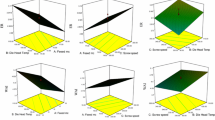Abstract
In this research, the effects of extrusion processing [exit-die temperature (120–150°C), moisture content (20–24% wet basis), and screw speed (260–340 rpm)] on the specific mechanical energy and physical properties (expansion ratio, bulk density, and hardness) of desi chickpea and hullless barley extrudates were estimated using response surface methodology. Exit-die temperature and feed moisture content, as well as the interaction between them were the factors that affected the product responses the most. Significant correlation was found between the hardness and bulk density (positive), hardness and expansion ratio (negative), and bulk density and expansion ratio (negative) for both chickpea and barley extrudates. Desirable characteristics (high expansion, low bulk density, and hardness) for chickpea were obtained at high exit-die temperature, relatively high moisture, and high screw speed. As for the barley extrudates, high exit-die temperature, low moisture, and moderate to high screw speed were identified as optimal.
Similar content being viewed by others
References
Santiago R, Moreira-Araújo R, Pinto E, Silva M, Arêas J. The potential use of extruded chickpea, corn and bovine lung for malnutrition programs. Innov. Food Sci. Emerg. 2: 203–209 (2001)
Brennan C, Brennan M, Derbyshire E, Tiwari B. Effects of extrusion on the polyphenols, vitamins and antioxidant activity of foods. Trends Food Sci. Tech. 22: 570–575 (2011)
Baik BK, Powers J, Nguyen LT. Extrusion of regular and waxy barley flours for production of expanded cereals. Cereal Chem. 81: 94–99 (2004)
Mathew JM, Hoseney RC, Faubion JM. Effects of corn sample, mill type, and particle size on corn curl and pet food extrudates. Cereal Chem. 76: 621–624 (1999)
Liu RH. Whole grain phytochemicals and health. J. Cereal Sci. 46: 207–219 (2007)
Meng X, Threinen D, Hansen M, Driedger D. Effects of extrusion conditions on system parameters and physical properties of a chickpea flour-based snack. Food Res. Int. 43: 650–658 (2010)
Wang N, Hatcher DW, Tyler RT, Toews R, Gawalko E. Effect of cooking on the composition of beans (Phaseolus vulgaris L.) and chickpeas (Cicer arietinum L.). Food Res. Int. 43:589–594 (2010)
Rachwa-Rosiak D, Nebesny E, Budryn G. Chickpeas-composition, nutritional value, health benefits, application to bread and snacks: A review. Crit. Rev. Food Sci. 55: 1137–1145 (2015)
Sosulski FW, Gadan HM. Variations in lipid composition among chickpea cultivars. J. Am. Oil Chem. Soc. 65: 369–372 (1998)
Singh S, Gamlath S, Wakeling L. Nutritional aspects of food extrusion: A review. Int. J. Food Sci. Tech. 42: 916–929 (2007)
Troëng, S. Oil determination of oilseed. Gravimetric routine method. J. Am. Oil Chem. Soc. 32: 124–126 (1955)
Box GEP, Hunter WG, Hunter SJ. Statistics for experimenters: An introduction to design, data analysis, and model building. Wiley, New York, USA. pp. 510–535(1978)
Hood SD, Tyler RT. Effect of protein, moisture content and barrel temperature on the physicochemical characteristics of pea flour extrudates. Food Res. Int. 43: 659–663 (2010)
Lai LS, Kokini JL. Physicochemical changes and rheological properties of starch during extrusion. Biotechnol. Progr. 7: 251–266 (1991)
Moraru CI, Kokini JL. Nucleation and expansion during extrusion and microwave heating of cereal foods. Compr. Rev. Food Sci. F. 2: 147–165 (2003)
Day L, Swanson BG. Functionality of protein-fortified extrudates. Compr. Rev. Food Sci. F. 5: 546–564 (2013)
Chinnaswamy R. Basis of cereal starch expansion. Carbohyd. Polym. 21: 157–167 (1993)
Rayas-Duarte P, Majewska K, Doetkott C. Effect of extrusion process parameters on the quality of buckwheat flour mixes. Cereal Chem. 75: 338–345 (1998)
Altan A, Mccarthy KL, Maskan M. Effect of screw configuration and raw materials on some properties of barley extrudates. J. Food Eng. 2: 377–382 (2009)
Author information
Authors and Affiliations
Corresponding author
Rights and permissions
About this article
Cite this article
Yovchev, A., Stone, A., Hood-Niefer, S. et al. Influence of the extrusion parameters on the physical properties of chickpea and barley extrudates. Food Sci Biotechnol 26, 393–399 (2017). https://doi.org/10.1007/s10068-017-0054-x
Received:
Revised:
Accepted:
Published:
Issue Date:
DOI: https://doi.org/10.1007/s10068-017-0054-x




